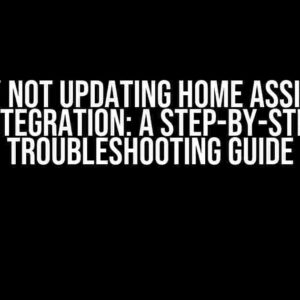Are you frustrated because you can’t download libraries to your Python project or update pip? You’re not alone! This is a common issue many Python developers face, and it’s usually due to a few simple reasons. In this article, we’ll walk you through a step-by-step guide to troubleshoot and fix this issue, getting you back to coding in no time.
Before We Begin
Before we dive into the solutions, let’s cover some basic checks to ensure you’ve got the basics covered:
- Make sure you have Python installed on your system (you can check by running
python --versionin your terminal/command prompt). - Verify that you’re using the correct Python version for your project (check your project’s requirements.txt file or the documentation).
- Confirm that you have an active internet connection (it sounds obvious, but it’s essential!)
Solution 1: Check Your pip Version
If you’re having trouble updating pip or installing libraries, it’s possible that your pip version is outdated. Let’s check and update pip:
python -m pip install --upgrade pip
If you’re using Python 3.x, you might need to use python3 -m pip install --upgrade pip instead. This command will upgrade pip to the latest version.
Solution 2: Verify Your Python Path
Sometimes, the issue lies with your Python path. Ensure that your Python executable is in your system’s PATH environment variable:
where python(on Windows)which python(on macOS/Linux)
This command will display the path to your Python executable. If it’s not in your PATH, you can add it manually:
- (Windows) Right-click on Computer/This PC > Properties > Advanced system settings > Environment Variables > Path > Edit > New > Add the path to your Python executable (e.g., C:\Python39\bin).
- (macOS/Linux) Open your shell configuration file (~/.bashrc, ~/.zshrc, etc.) and add the following line:
export PATH=$PATH:/usr/local/bin/python(replace with your Python executable’s path). Restart your terminal or runsource ~/.bashrcto apply the changes.
Solution 3: Disable Any Firewalls or VPNs
Firewalls or VPNs might be blocking your pip connections. Try temporarily disabling them to see if it resolves the issue:
If you’re using a VPN, try disconnecting and then installing/updating pip again. If you’re using a firewall, disable it momentarily and try again.
Solution 4: Check for Proxy Settings
If you’re behind a proxy server, you might need to configure pip to use it. Check your system’s proxy settings and update pip accordingly:
pip config set global.proxy http://your-proxy-server:port
Replace http://your-proxy-server:port with your actual proxy server’s address and port number.
Solution 5: Clear pip’s Cache
Sometimes, pip’s cache can become corrupted. Clearing it might resolve the issue:
pip cache clean
Solution 6: Reinstall pip
As a last resort, you can try reinstalling pip:
python -m ensurepip --upgrade
This command will reinstall pip and upgrade it to the latest version.
Troubleshooting Common Errors
We’ve covered the main solutions, but you might encounter specific errors during the process. Here are some common errors and their fixes:
| Error | Solution |
|---|---|
SSL: CERTIFICATE_VERIFY_FAILED |
Try updating your certificates using pip install certifi --upgrade or pip install --trusted-host pypi.org --trusted-host files.pythonhosted.org. |
Connection to pypi.org refused |
Check your firewall/VPN settings, and try again. If you’re behind a proxy, update pip’s proxy settings as mentioned earlier. |
Permission denied |
Run pip with administrator privileges (using sudo on macOS/Linux or right-clicking the command prompt and selecting “Run as administrator” on Windows). |
pip is not recognized as an internal or external command |
Verify that pip is installed and configured correctly, and that your Python executable is in your system’s PATH environment variable. |
Conclusion
By following these steps and troubleshooting common errors, you should be able to download libraries to your Python project and update pip. Remember to stay patient and methodical, as each solution might take some time to execute. If you’re still facing issues, consider reaching out to the Python community or seeking help from a fellow developer.
Happy coding, and may the pip be with you!
Additional Resources
Stay tuned for more Python-related articles and guides!
Frequently Asked Question
Stuck in a jam? Can’t download libraries to your Python project, and Pip’s not cooperating either? Don’t worry, we’ve got the solutions for you!
Q1: Why am I getting a “Permission Denied” error while trying to install libraries?
Ahh, those pesky permissions! Try running your command prompt or terminal as an administrator. On Windows, right-click on the Command Prompt icon and select “Run as administrator.” On Mac/Linux, use `sudo` before your pip install command. This should give you the necessary permissions to install those libraries!
Q2: Is my internet connection the culprit behind my failed downloads?
Yeah, that’s a good point! A slow or unstable internet connection can definitely cause issues. Try checking your internet speed and stability. You can also try restarting your router or contacting your internet service provider if the problem persists. Once you’ve got a stable connection, try downloading those libraries again!
Q3: Can I update Pip in a virtual environment?
Absolutely! You can update Pip in a virtual environment using the `–upgrade` flag. Just type `python -m pip install –upgrade pip` in your terminal or command prompt. This will ensure you’ve got the latest Pip version, even in your virtual environment!
Q4: What’s the deal with firewall restrictions blocking my downloads?
Ah-HA! Those firewall restrictions can be a real pain! You might need to configure your firewall settings to allow downloads from certain sources. Check your firewall settings and add exceptions for the Python package repositories (like PyPI) or use a proxy server if necessary. This should help you bypass those restrictions and download those libraries!
Q5: Are there any alternative package managers I can use if Pip’s not working?
You bet! If Pip’s not cooperating, you can try using alternative package managers like `conda` or `pipenv`. These managers can help you install and manage packages for your Python projects. Just remember to install them separately and follow their specific instructions for use!






